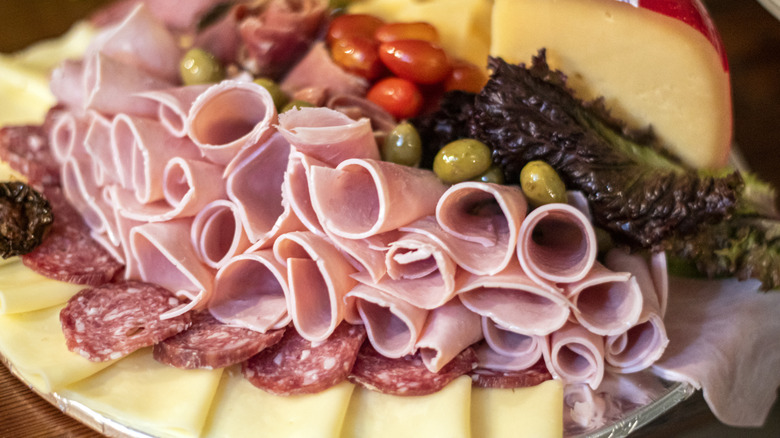The Once-Popular Deli Meat No One Eats Anymore
Let's face it, deli meats are one of life's simple pleasures. Savory, perfectly seasoned, and effortlessly convenient, they're ideal in a sandwich for a quick grab-and-go snack, or as the finishing touch to a well-curated, elegant charcuterie board. Countless deli meats are celebrated as tried-and-true culinary classics: think smoked pastrami or the Hawaiian delicacy Spam, whose rich flavors and timeless appeal have made them staples in kitchens and delicatessens around the world. Other deli meats have had a brief moment in the spotlight, but then faded back into obscurity. Take olive loaf, for example. Nowadays, it seems this once-popular deli meat is nowhere to be found.
Although it earned a cameo in the pop culture classic "The Breakfast Club," a quick online search for "olive loaf" today will more likely lead to a similarly named, rustic bread recipe. But olive loaf isn't a carb; it's a cold cut. Specifically, it's sliced deli meat mixed with spices and studded with green olives and their trademark red pimentos. It's described as being similar to mortadella or bologna, which each have their own distinct characteristics. Like many deli classics — but not all of them — olive loaf is highly processed and not exactly picky about what kind of meat goes into it. Just take a look at Oscar Mayer's version, which is a blend of chicken and pork, while Boar's Head prefers to incorporate beef and pork into its rendition. While olive loaf can be enjoyed on it's own, it truly shines in a sandwich layered with crispy lettuce, ripe tomatoes, and a touch of mustard, and much like a bologna, it could pair surprisingly well with hot honey for a next-level experience.
What happened to olive loaf?
Like many deli meats, olive loaf's prime was in the 1970s, when it was standard lunchbox fare. On Reddit, a photo of the nostalgic lunch meat was met with a surprising amount of fondness, with one user commenting, "Olive loaf! Growing up ... we had this regularly in sandwiches. Great reminder of my childhood!" So what exactly happened to this once-popular luncheon meat, and why is it no longer a lunchbox staple today?
The rise and fall of olive loaf is a story shaped by shifting food trends and cultural attitudes. Olive loaf belongs to the broader category of luncheon meats: pre-cooked, cured, or processed cuts sold sliced or canned for convenience and affordability — think bologna, pimento loaf, or pepperoni — which gained popularity in the 1970s and '80s thanks to major brands like Oscar Mayer making them widely available at a low cost.
By the 1990s, however, concerns about nutrition began to reshape American eating habits. Processed meats, often high in sodium and saturated fats, clashed with the era's low-fat craze, a time when people saw cutting saturated fats out of their diets as the ultimate key to better health and longevity. "Through the 1990s, bologna sales in general — no matter what manufacturer — fell one percent each year," Michael Moss writes in his 2013 book "Salt Sugar Fat." This steady decline, coinciding with an intentional shift towards lower-fat diets, likely explains why olive loaf has practically disappeared from store shelves, leaving a new generation largely unfamiliar with what was once a popular deli meat.


